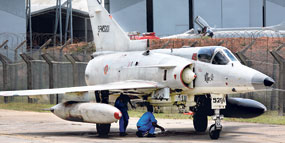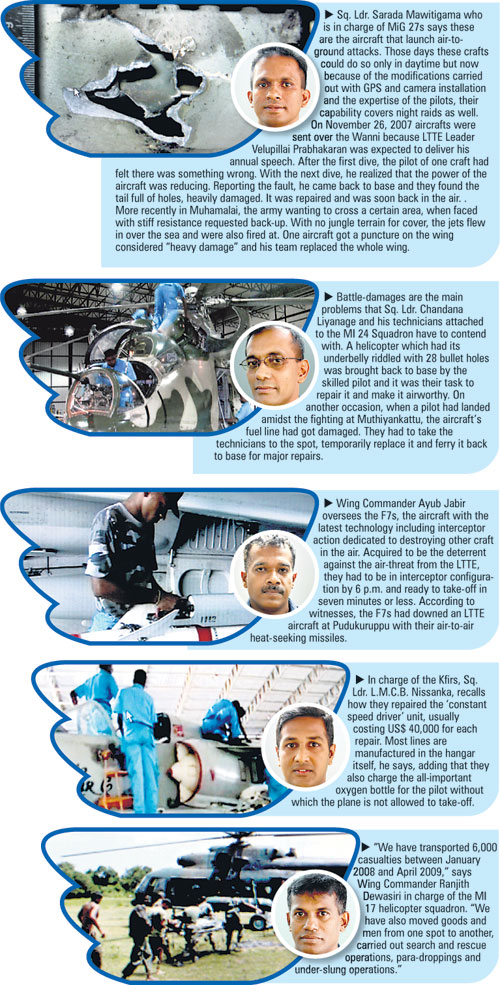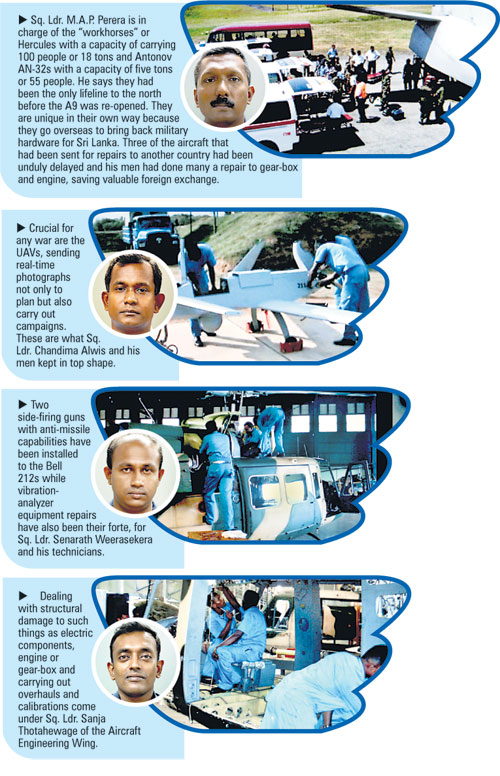Many were the times that they carried out sorties into the theatres of war where the battle was raging, not only to hit at specific terrorist targets but also to land amidst the thick fighting to evacuate their brother soldiers. Theirs were also those vital photographs, taken both day and night, that helped attack Tiger strongholds without harming innocent civilians.
In the other parts of the country, away from the battleground, as they zoom overhead like tiny specks, leaving a trail of white high up in the sky or manoeuvre into acrobatic stance in the air during celebrations, most people rightly associate the Sri Lanka Air Force (SLAF) with its courageous and heroic pilots.
But when the mighty jets or bombers or even their humble cousins, the training or transport planes, get splattered with gunfire or begin to malfunction who is there round-the-clock to patch up the severe damage or, facing delays with sparepart imports, coax over-tired engines to get back into fighting mode, ensuring in the process that the pilots will not be in danger?
They are the “nut and bolts” men, the silent workers in their “majan-smeared” blue overalls scattered across the country not only at the mother-bases of the SLAF but also at other smaller bases.
Mostly unsung about, they toil and sweat over the aircraft like mothers looking after their babies, getting a thumbs-up from the grateful pilots and a pat on the back from Commander Air Chief Marshal Roshan Goonetilleke and his high-ranking officers.
A few days ago, the Sunday Times got a glimpse of their world -- the ‘Directorate of Aeronautical Engineering’ -- and the expertise and tireless activity they have put into the war effort. This directorate is responsible for aircraft maintenance and servicing encompassing the engine, air-frame, avionics, electrical-instruments and safety equipment.
 |
Air Commodore
Kumarasiri |
“Our responsibility is to keep the SLAF’s craft in the air,” says Director of Aeronautical Engineering, Air Commodore Jayanath Kumarasiri, explaining that they have to maintain optimum “serviceability status”. Their mandate is to keep the aircraft flying in “full mission capable status”, he says, adding with a touch of pride that in fighting aircraft “we achieved 75% serviceability”.
He and his staff have more than 100 aircraft comprising Kfirs, MiG 27s, MI 24s and F7s; training and transportation aircraft; reconnaissance aircraft and Unmanned Aerial Vehicles (UAVs), under their expert care.
While the Kfirs and MiG 27s are fighter-bombers, MI 24s are close-support attack helicopters and F7s are interceptors with bombing capability. UAVs which have day and night cameras send real-time photographs that are an invaluable aid for the army to plan its ground campaign, for the soldiers’ vision is obstructed by sandbags and other barriers erected by the terrorists, explains Air Commodore Kumarasiri.
His team comprises Officers Commanding Maintenance (OCMs) based with each of the flying squadrons of the SLAF, and technicians under them who worked 24 hours a day during the war. Even for Air Commodore Kumarasiri, many were the sleepless nights because “I authorize the work and I take the responsibility”.
The servicing pattern for the aircraft is laborious and has to be meticulous, the Sunday Times understands. Before an aircraft takes off there has to be “flight servicing” and when it comes back a “turnaround servicing” before its next flight. Then there are also “the planned servicing” to be carried out after a certain number of calendar flying hours such as 25, 50, 100 and 200 hours.
Component changes and lubrication are vital as well as visual inspections for cracks, snags and deformities because there are a lot of forces which come into play with regard to an aircraft, he says. “The aircraft have mostly rotational components and these can and do wear-off easily.”
Loading and unloading of armaments such as 80 mm rockets, 23 mm guns, 250-kilo bombs called S24B and also changing the configuration of the “hard points” where each armament is fixed are also part of their skilled but routine duties.
Clockwork precision is required, he says, explaining that in wartime soon after a sortie, another would take place, hardly giving time for servicing, system and battle-damage checks and armament loading before the aircraft is pushed once again into the flight line.
Citing just one from numerous examples, leaving his OCMs to brief the Sunday Times on the others, Air Commodore Kumarasiri points out that suddenly a beach-craft vital for reconnaissance, developed engine failure during the recent fighting.
“An engine was required urgently from the pool, but there were none available. We would have had to face a long wait of about two months, time we couldn’t wait,” he says and his OCMs would just not hang around idling.
They took a life-expired engine, stripped it and put it together again, monitored it daily checking parameter developments especially the crucial temperature, which if it goes too high or too low is a problem.
This engine which had done its maximum of 3,600 hours of flying should have mandatorily undergone an overhaul. But we did our own inspection and cleared it for flying to meet operational requirements, he said, adding that “it was an engineering decision”.
Did you know that the two Hercules C130s have not flown together for nine years because invariably one or the other has been grounded, he asks, adding quickly that they did fly together on Independence Day this year and also during the Victory Parade. “Although the air-starter in one engine failed when the craft was on the ground, we did a ‘buddy-start’ with the jet stream of one rotating the propeller of the other and got them into the air.”
What of the beach-craft now that the war is over? Like all the men in the SLAF who are maintaining their standards, the beach-craft is still flying.
“We have given new life to the old engine, says this Air Commodore simply, “without compromising the safety of the pilots. My ‘tradesmen’ are A-class.”
|




